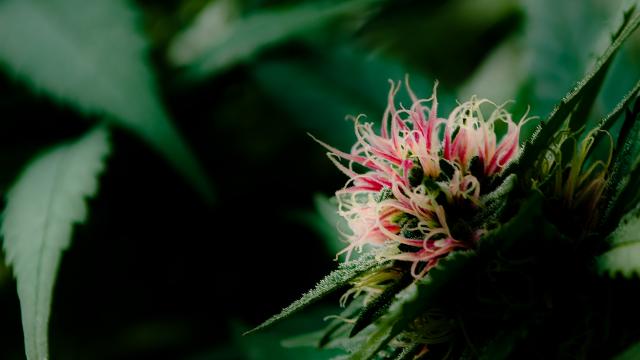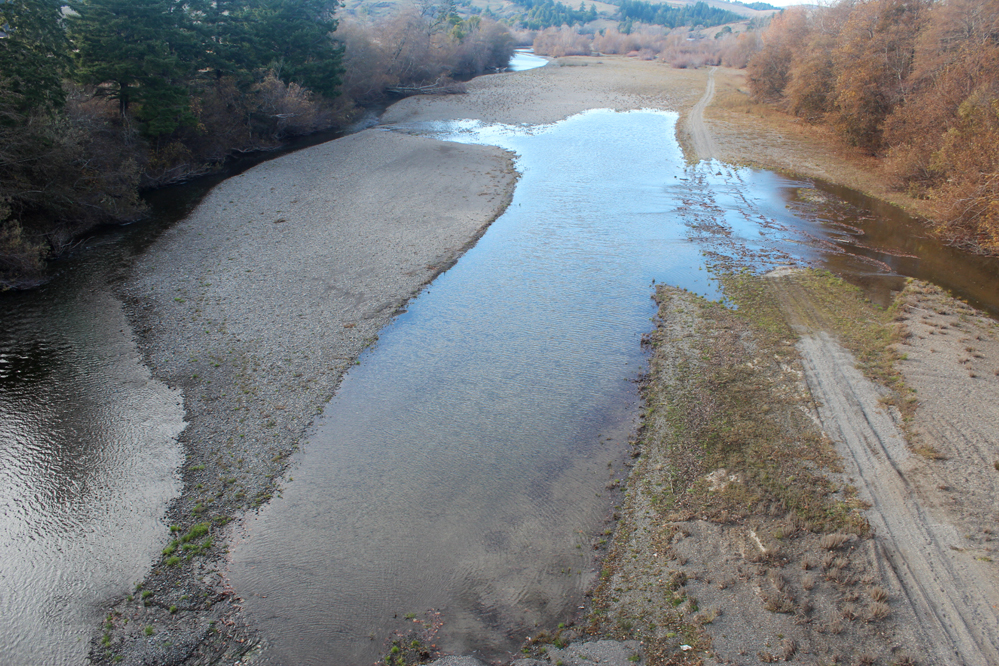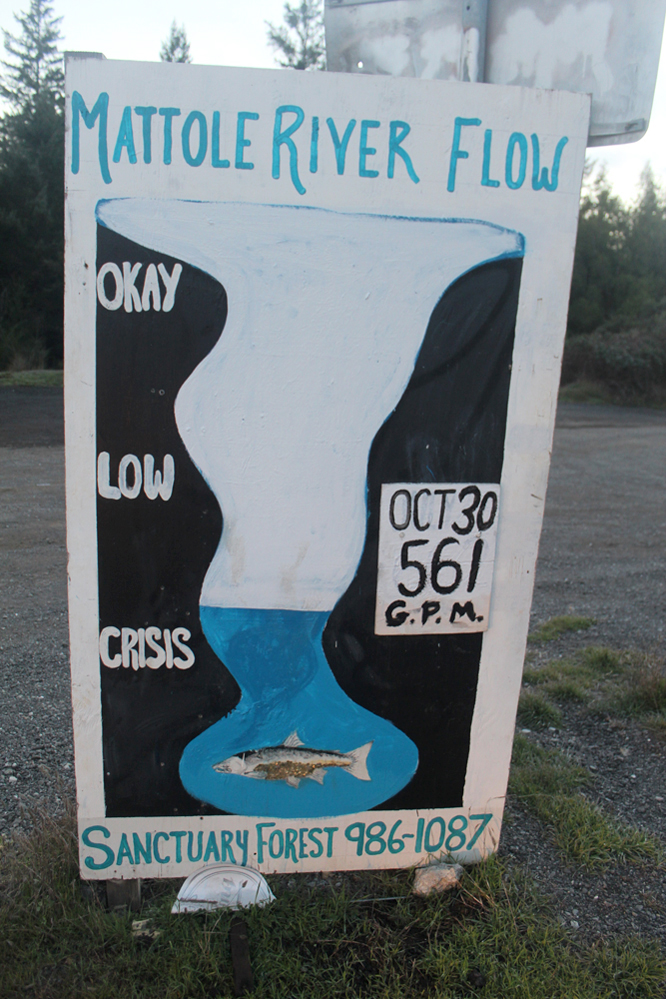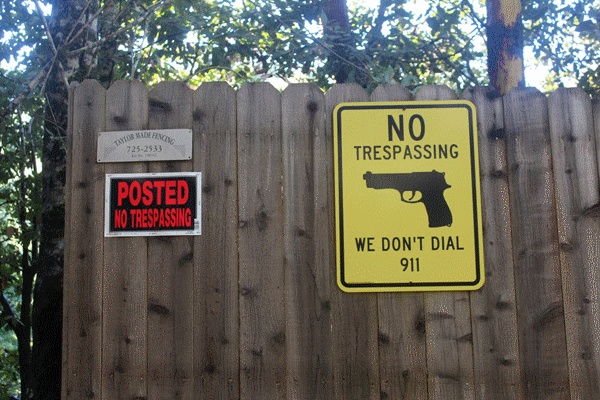
Last fall, we traveled around California's Humboldt County speaking with local pot growers, restoration councils and “Back-to-the-Landers,” gathering notes. The water we drank came from the Mattole River, which drains over 300 square miles of hillsides and mountains as it traverses 62 miles to the Pacific Ocean.
The Mattole River Valley has for years been devastated by careless logging practices. The watershed is still struggling to recover, despite the restoration efforts of the Back-to-the-Land movement. But now large pot grows – and the culture of greed that comes with such a gold rush – risk damaging the watershed further, undermining the restoration work and subverting the land ethic that has become a key part of the culture here.
We took a Greyhound up to Garberville in October and were greeted by a drunk man smoking a thumb-sized spliff with his prepubescent son in a gargantuan pick-up truck. “Ya lookin' for work?” he asked.
Humboldt County, as many know, has become infamous for providing the United States with pot. “SoHum” (Southern Humboldt) culture is open about the fact that people's livelihoods are built on weed. Fiskers – scissors used to trim buds – are sold at the grocery checkout aisle, and in the season we visited the local gossip concerned a high school kid who grew 400 pounds in a season, bought a shmaltzy truck, crashed it and bought another.
One popular bumper sticker reads, "SAVE HUMBOLDT COUNTY, KEEP WEED ILLEGAL." Traveling-kid knowledge is that if you want money, hitch around Humboldt during harvest season and someone's bound to ask, "Ya lookin' for work?" before driving you to their grow “up in the hills...”
One of Humboldt's backwoods is known as California's “Lost Coast,” so-called because the mountain terrain is so treacherous that even meandering coastal Highway 1 cannot cross it. Not long ago, the area was covered in ancient forest – Douglas Firs and Redwood trees,thousands of years old and taller than skyscrapers – but following World War II, soldiers returned and wanted homes. Technology that had been developed for tank warfare was used to build logging equipment, and in a short period nearly all the trees here were chopped down.
The Back-to-the-Landers – a contingent of San Francisco's flower children – began migrating to the Lost Coast in the early 1970s. "When we arrived, we didn't know our asses from a hole in the ground," David Simpson, a homesteader and co-founder of the Mattole Salmon Group, told us. But the “new settlers” were eager to figure it out.
"We came here looking for lives that were not at war with the natural world, a life that did not require us to sacrifice the natural world for our own comforts," he said.
Property was cheap. The land was mostly logged over and considered undesirable. Logging had also ravaged the local watershed; logging roads built willy-nilly around the hills had eroded the land, and excess sediment spilled into the Mattole destroying natural habitat and causing the river to widen and grow shallow. Salmon were prevented from reaching their preferred spawning tributaries upstream.
A salmon is born in the calm headwaters of a river and before long drifts down to the Ocean where she spends a few years fattening up, growing strong. Then, when the rain hits the Coast – raising the water level and opening the river's mouth – the salmon ferociously beats her way upstream, jumping over waterfalls, leaping upward over strong currents. Using only her sense of smell, the salmon makes her way to the very same river – often the very same tributary – in which she was born, where she will spawn, and die.
When the Back-to-the-Landers came to the area, they'd heard tales of fleshy, silvery native chinook and coho salmon that would arrive each year in groups so plentiful that one could walk across the Mattole on their backs. But by the mid 1970s, the river was so damaged that the Department of Fish and Game informed locals that their native stocks were in severe decline.
Simpson and other “new settlers” built a mini-hatchery and began taking on some of the vast habitat restoration work that needed to be done. The dogged hippies, aided by a few older ranchers, devoted their energy to helping restore the Mattole salmon population and their habitat. The Mattole Salmon Group was formed in 1980 and restoration, a concept new to the Mattole community, became a key part of the local culture.
But they still needed to make money, so "some Back-to-the-Landers started to grow pot," Simpson told us. They brought the cash crop to the area and introduced Sinsemilla (dank, potent seedless buds, in which only the females are allowed to blossom) to the area. However, cultivating weed was never the top priority, certainly not in the beginning, and “growing pot” meant growing a handful of plants.
It did not mean manning industrial-sized farms the way people are doing today.
Greed can suck a culture dry. Michael Evenson, another long-time community member, sighed as he told us that pot farms “went on steroids” when the children of Back-to-the-Landers realized that a single plant was worth a thousand bucks or more.
“The Reagan years reached here with the pot money and basically subverted the land ethic into a monetary ethic,” Evenson said, describing the glossy plastic greenhouses that began sprouting up like “giant maggots on the hillside.” Big trucks started rolling in, as did out-of-towners who arrived not to steward the land, but to get rich fast.
It's estimated that at least 4,000 commercial growers live in the area today, and their mostly black market sales generate around $400 million each year.
All of which means: no more wandering around the land like a carefree hippie. "We used to walk all over the countryside," added Evenson. "With the timber company, for all the ills of destroying the landscape, at least the land was open. With pot growing, the land was closed."
Today, despite all the talk of how-many-pounds-did-you-grow, there is a strong ethic of privacy – more like hush-hush paranoia – throughout these hills. We gave up on trying to go for a country stroll because everywhere we walked we were greeted with NO TRESPASSING signs and the yelps of guard dogs (not to mention caged wolves).
So the question is: just how damaging is weed culture to the Lost Coast, and how much river do these pot plants suck dry?
We visited a small-scale grower – who happily sticks to the 99 plants he's legally allowed to harvest, thanks to his medical marijuana card – who casually mentioned that he'd lost 4,500 gallons of water the previous night because his tank sprang a leak. Naturally, he stuck his pump back into the river and refilled the tank. How often does this happen? It's hard to say, but it's also common knowledge that growers here continue to pump from the rivers even during the dry season, despite the fact that there are laws against it.
Another question is quality. Today, less than 10% of Humboldt's pot is grown organically. Longtime hippie growers have attempted to fight more recent, short-sighted, toxic growing practices. The Humboldt Medical Marijuana Advisory Panel, established in 2009, labels big growers “the corporadoes and pirates that befoul our culture.”
Anthony Silvaggio, from Humboldt State University's newly established Institute for Interdisciplinary Marijuana Research, made this videousing Google Earth images, showing the devastation wrought by big grows.
In addition, news coming out of Northern California these days is full of stories about the waste left behind from large-scale illegal grows. Clean-up crews find trash and poisonous chemicals – rodenticides, herbicides, insecticides – scattered across the forest floor. They stumble upon land where creeks have been diverted, where trees were felled and the earth razed to make more room for weed.
It's tempting to wag a finger at pot farmers for damaging the watershed. But, as David Simpson was quick to remind us, the logging industry did more damage than even the nastiest grows can do. Articles might talk about 'stumbling' on secret grows, but "one wouldn't have to 'stumble' on diverted creeks and razed earth in the logging days," he said.
"That's mostly what was out there back then. In terms of disturbed landscapes, the excesses of the pot boom still compare favorably to the logging practices that came before. Moving logs that weigh several tons generally leaves a larger mark on the earth than the hugest of marijuana plants, and while pot farmers often cut some trees down to make light or space for plants, their target is not the trees themselves. The logging exposed much more of the landscape.”
But beyond the ecological footprint and comparisons with the region's past, today's pot story – a narrative told of big bad drug dealers hiding out in the hills, striking big green on the black market – still sounds sexy, and people are far from through speculating on where the trend is going.
"The pot story is really exciting," said Cassie Pinnell, director of the Mattole Restoration Council. "But I get worried that people look for one answer. Even if people stopped growing pot, we'd still see [the effects of] climate change and this mid-state ecosystem that really got hammered."
Eight out of the past 12 years have been the driest in the history of the Mattole watershed. And while locals say it's nice that the Z'berg-Nejedly Forest Practice Act of 1973 requires logging companies to plant new trees for every ancient one they fell, the new-growth forest swallows a lot of water.
As Cassie said, the young forest is akin to “a watershed-wide mono-crop.” And with the river flow so low these days, watering one's cash crop – and marijuana requires a lot of water – means taking “the last drops from the last drops.”
3 WAYS TO SHOW YOUR SUPPORT
- Log in to post comments


















